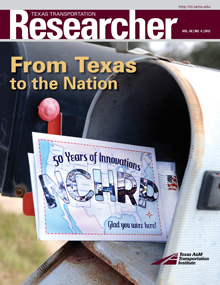Are we counting motorcycles accurately?
Statistics from 2000 and 2008 indicate that motorcycle fatalities increased by 83 percent. During the same time period, the vehicle miles traveled (VMT) by motorcycles increased by only 38 percent. Is this a deadly trend, or are the VMT numbers valid?
“The numbers we’re counting don’t reflect the rise in crashes, injuries and fatalities,” notes Texas A&M Transportation Institute (TTI) Research Engineer Dan Middleton. “Are we counting motorcycles well enough? The answer is no.”
NCHRP Project 08-81, Improving the Quality of Motorcycle Travel Data Collection, tasked Middleton with reviewing current traffic detection methods, investigating new technologies and reporting on which count motorcycles the best.
“Motorcycle fatalities are increasing on our roadways, but data haven’t shown much change in VMT for several years,” explains Christopher Hedges, NCHRP senior program officer. “That gives us a perception — one that is quite likely erroneous — that higher fatalities are resulting from some characteristics of the rider, the road or the motorcycle itself.”
Current detection technologies are divided into two categories: intrusive and non-intrusive. Intrusive detectors, like piezoelectric cables, require some modification of the pavement. Non-intrusive detectors, like passive infrared systems, are mounted above or beside the roadway.
Which ones work best? According to Middleton, piezoelectric cables work fine (particularly when brand new), but they require lane closures for installation and maintenance. Also, many agencies install sensors covering only half the lane width, allowing motorcycles to be missed. Preliminary results from recent tests on passive infrared systems in Florida indicate that infrared sensors distinguish motorcycles from cars and count the former correctly.
The methodology used to count motorcycles is also at issue. For example, consider the two distinct rider groups: commuters and recreational riders. Each group has a distinct riding pattern. Count locations for recreational riders are probably different from those for commuters.
“If you want to get a representative sample, you can’t just count urban areas. Commuters ride on weekdays, but recreational riders ride on weekends and holidays, and often on back roads,” Middleton says.
Middleton is using motorcycle crash reports to determine whether crash locations are good identifiers of count sites. Preliminary evidence from two states indicates that this method will work.
“Crashes happen where motorcycles travel. We used data to create a map that shows both motorcycle crash locations and motorcycle counts along all roadways. We haven’t found anything else that predicts where to count in these rural areas,” Middleton says.
The project couldn’t have come at a better time since states are now required to report motorcycle travel to the federal Highway Performance Monitoring System.
“Until we have a good understanding of true motorcycle volumes, we won’t have a good measure of exposure rates — the number of crashes and fatalities as a factor of actual motorcycle miles traveled,” Hedges says. “Without that kind of knowledge, it’s impossible to develop safety programs that address real needs and the right risk factors. This project has the potential to make a real difference in our understanding of motorcycle safety.”



